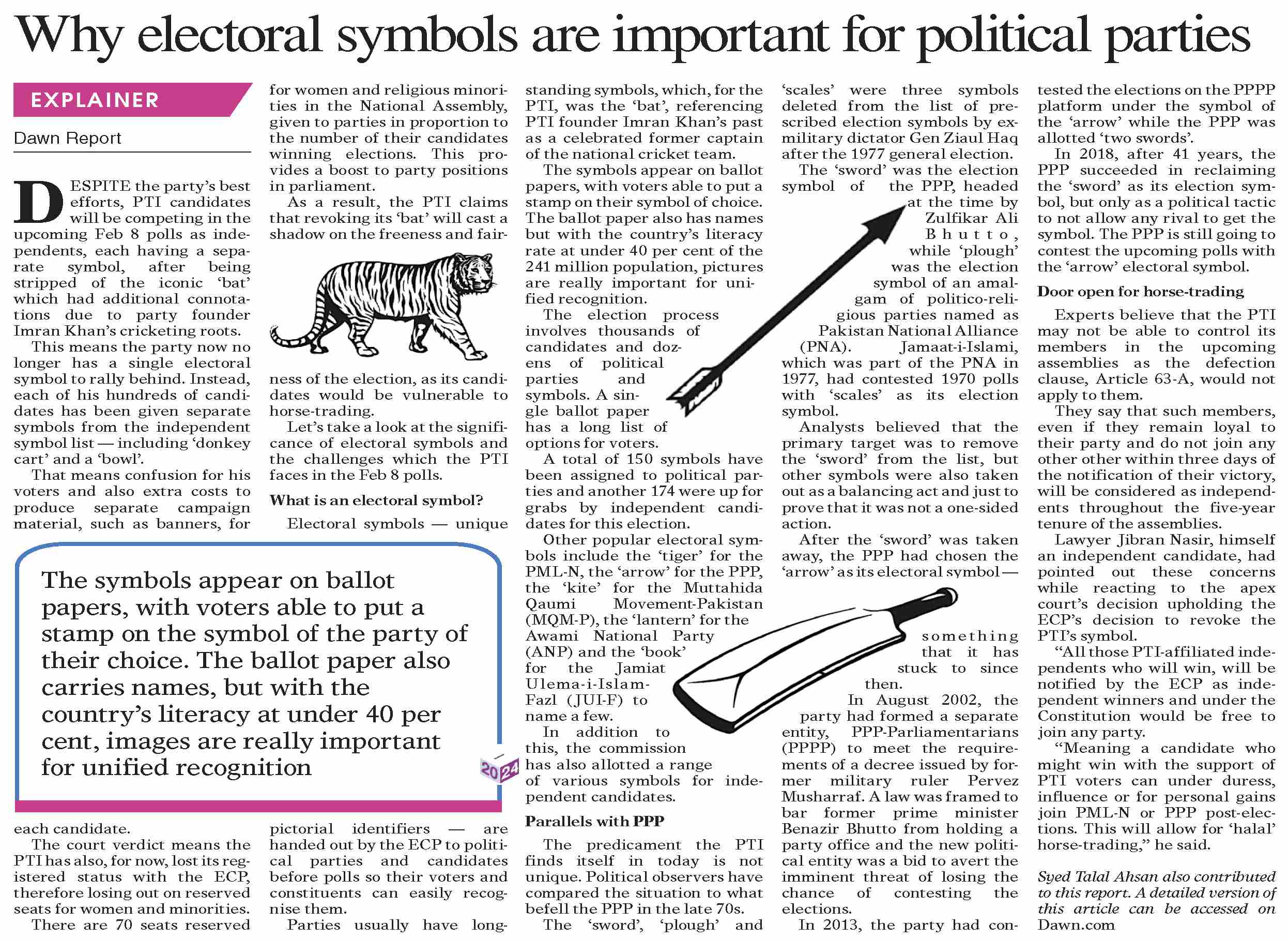Importance of Electoral Symbol for Political Parties in Pakistan Politics – Why is it necessary for a political party to have election symbol to contest an election in Pakistan ? Its Importance, repercussions, political benefit and drawbacks in detail
Why electoral symbols are important for political parties
DESPITE the party’s best efforts, PTI candidates will be competing in the upcoming Feb 8 polls as independents, each having a separate symbol, after being stripped of the iconic ‘bat’ which had additional connotations due to party founder Imran Khan’s cricketing roots. This means the party now no longer has a single electoral symbol to rally behind. Instead, each of his hundreds of candidates has been given separate symbols from the independent symbol list — including ‘donkey cart’ and a ‘bowl’. That means confusion for his voters and also extra costs to produce separate campaign material, such as banners, for women and religious minorities in the National Assembly, given to parties in proportion to the number of their candidates winning elections. This pro-vides a boost to party positions in parliament. As a result, the PTI claims that revoking its ‘bat’ will cast a shadow on the freeness and fairness of the election, as its candidates would be vulnerable to horse-trading. Let’s take a look at the significance of electoral symbols and the challenges which the PTI faces in the Feb 8 polls. What is an electoral symbol? Electoral symbols unique.
The symbols appear on ballot papers, with voters able to put a stamp on the symbol of the party of their choice. The ballot paper also carries names, but with the country’s literacy at under 40 per cent, images are really important for unified recognition
each candidate. The court verdict means the PTI has also, for now, lost its registered status with the ECP, therefore losing out on reserved seats for women and minorities. There are 70 seats reserved
pictorial identifiers are handed out by the ECP to political parties and candidates before polls so their voters and constituents can easily recognize them. Parties usually have long standing symbols, which, for the PTI, was the ‘bat’, referencing PTI founder Imran Khan’s past as a celebrated former captain of the national cricket team. The symbols appear on ballot papers, with voters able to put a stamp on their symbol of choice. The ballot paper also has names but with the country’s literacy rate at under 40 per cent of the 241 million population, pictures are really important for unified recognition. The election process involves thousands of candidates and dozens of political parties and symbols. A sin-gle ballot paper has a long list of options for voters. A total of 150 symbols have been assigned to political par-ties and another 174 were up for grabs by independent candidates for this election. Other popular electoral symbols include the ‘tiger’ for the PML-N, the ‘arrow’ for the PPP, the ‘kite’ for the Muttahida Qaumi Movement Pakistan (MQM-P), the ‘lantern’ for the Awami National Party (ANP) and the ‘book’ for the Jamiat Ulema-i-Islam-Fazl ( JUI-F) to name a few. In addition to this, the commission has also allotted a range of various symbols for inde-pendent candidates.
`scales’ were three symbols deleted from the list of pre-scribed election symbols by ex-military dictator Gen Ziaul Haq after the 1977 general election. The ‘sword’ was the election symbol
of the PPP, headed at the time by Zulfikar Ali Bhutto, while ‘plough’ was the election symbol of an amalgam of politico-religious parties named as Pakistan National Alliance (PNA). Jamaat-i-Islami, which was part of the PNA in 1977, had contested 1970 polls with ‘scales’ as its election symbol. Analysts believed that the primary target was to remove the ‘sword’ from the list, but other symbols were also taken out as a balancing act and just to prove that it was not a one-sided action. After the ‘sword’ was taken away, the PPP had chosen the `arrow’ as its electoral symbol.
Parallels with PPP The predicament the PTI finds itself in today is not unique. Political observers have compared the situation to what befell the PPP in the late 70s. The ‘sword’, ‘plough’ and something that it has stuck to since then. In August 2002, the party had formed a separate entity, PPP-Parliamentarians (PPPP) to meet the requirements of a decree issued by former military ruler Pervez Musharraf. A law was framed to bar former prime minister Benazir Bhutto from holding a party office and the new political entity was a bid to avert the imminent threat of losing the chance of contesting the elections. In 2013, the party had contested the elections on the PPPP platform under the symbol of the ‘arrow’ while the PPP was allotted ‘two swords’. In 2018, after 41 years, the PPP succeeded in reclaiming the ‘sword’ as its election symbol, but only as a political tactic to not allow any rival to get the symbol. The PPP is still going to contest the upcoming polls with the ‘arrow’ electoral symbol. Door open for horse-trading Experts believe that the PTI may not be able to control its members in the upcoming assemblies as the defection clause, Article 63-A, would not apply to them. They say that such members, even if they remain loyal to their party and do not join any other other within three days of the notification of their victory, will be considered as independ-ents throughout the five-year tenure of the assemblies. Lawyer Jibran Nasir, himself an independent candidate, had pointed out these concerns while reacting to the apex court’s decision upholding the ECP’s decision to revoke the PTI’s symbol. “All those PTI-affiliated independents who will win, will be notified by the ECP as independent winners and under the Constitution would be free to join any party. “Meaning a candidate who might win with the support of PTI voters can under duress, influence or for personal gains join PML-N or PPP post-elections. This will allow for ‘halal’ horse-trading,” he said.



